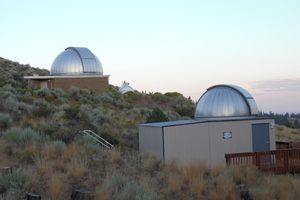
The eastern Oregon high desert, with its clear air and low population density, has night skies as dark as anywhere in the conterminous 48 states. It’s hardly surprising, then, that the University of Oregon has located a research observatory there, on 6,349-foot (1,935-meter) Pine Mountain, just southeast of Bend.
The investigations that led to the establishment of the observatory date from the late 1950s, when astrophysicist E.G. “Eb” Ebbighausen was looking for a dark site for his work on binary stars. He found that sites by the Cascade Range, although closer to the campus in western Oregon, were too often cloudy. Consulting with the Forest Service and local astronomy buffs led him to Pine Mountain.
Besides Ebbighausen’s research on binary stars, other research includes studies of dim galaxies in the 2000s. The 24-inch Boller & Chivens telescope (mentioned below) also made the first observations, in 1970, of magnestars, white dwarf stars with extraordinarily strong magnetic fields.
The current facilities include a 15-inch Fecker Cassegrain telescope, which dates back to 1950. In 1961, Ebbighausen used it in his scouting for a dark-sky site, and it was installed at Pine Mountain Observatory in 1968. It was restored and reinstalled in 2015 and is now used for public outreach and student projects. The Boller & Chivens 24-inch telescope was the first constructed at the observatory, in 1967. Currently it is also used for outreach and student projects. (Alas, a 32-inch telescope has been out of commission since 2000 due to a catastrophic mechanical failure in its drive.)
At present, the focus of the observatory is on undergraduate research and public outreach, with public events on most summer weekends. As Ebbighausen was also the author of a standard astronomy text that was revised into the 1970s, undergraduate research fits well with his legacy. In establishing the observatory, Ebbighausen also focused on grassroots public support, so outreach is also part of his legacy.

